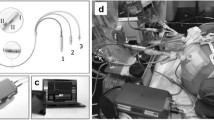Abstract
Background: The benefits of monitoring cerebral blood flow (CBF) in stroke patients are apparent. New techniques combining near infrared spectroscopy (NIRS) and indocyanine green (ICG) dye dilution to estimate cerebral hemodynamics are available. However, with transcutaneous NIRS and optodes applied over the skin, the signal is contaminated by extracerebral tissues. The objective is to develop a new brain tissue probe for combined monitoring of intracranial pressure (ICP), CBF and cerebral blood volume (CBV).
Methods: Conventional intraparenchymal probes for ICP monitoring are supplied with optical fibers. The light is coupled into the brain tissue and collected after absorption and scattering with a light detector. Venous injections of 0.2 mg/kgbw ICG are performed. The mean transit time of ICG (mttICG), CBF and CBV are calculated.
Results: With a prototype of the probe in a first patient with subarachnoid hemorrhage 6 pairs of repetitive measurements were performed. Mean values were for mttICG 5.6 ± 0.2 s, CBF 22.3 ± 2.8 ml/100 g/min and CBV 2.1 ± 0.3 ml/100 g.
Conclusions: NIR spectroscopy allows the synchronous determination of multiple parameters with one single device. By measurements in parallel with the NeMo Probe and NIRS optodes placed over the skin, new algorithms can be developed to subtract the extracerebral contamination from the NIRS signal.
Access this chapter
Tax calculation will be finalised at checkout
Purchases are for personal use only
Similar content being viewed by others
References
Aaslid R, Huber P, Nornes H. Evaluation of cerebrovascular spasm with transcranial doppler ultrasound. J Neurosurg. 1984;60:37–41.
Bhatja A, Gupta AK. Neuromonitoring in the intensive care unit.I. Intracranial pressure and cerebral blood flow monitoring. Intensive Care Med. 2007;33:1263–1271.
Colacino JM, Grubb B, Jobsis FF. Infra-red technique for cerebral blood flow: comparison with xenon 133 clearance. Neurol Res. 1981;3:17–31.
Germon TJ, Evans PE, Barnett NJ, Lewis TT, Wall P, Nelson RJ. Changes in tissue oxyhemoglobin concentration measured using multichannel near infrared spectroscopy during internal carotid angiography. J Neurol Neurosurg Psychiatry. 1997;63:660–664.
Heiss WD, Graf R, Löttgen J, Ohta K, Fujita T, Wagner R, et al. Repeat positron emission tomographic studies in transient middle cerebral artery occlusion in cats: residual perfusion and efficiacy of postischemic reperfusion. J Cerebr Blood Flow Metabol. 1997;17:388–400.
Hongo K, Kobayashi S, Okudera H, Hokama M, Nakagawa F. Noninvasive cerebral optical spectroscopy: Depth-resolved measurements of cerebral hemodynamics using indocyanine green. Neurol Res. 1995;17:89–93.
Hopton P, Walch TS, Lee A. Measurement of cerebral blood volume using near-infrared spectroscopy and indocyanine green elimination. J Appl Physiol. 1999;87:1981–1987.
Keller E, Nadler A, Alkhadi H, Kollias S, Yonekawa Y, Niederer P. Non invasive measurement of regional cerebral blood flow and regional cerebral blood volume by near infrared spectroscopy and indocyanine green dye dilution. Neuroimage 2003;20:828–839.
Keller E, Nadler A, Niederer P, Yonekawa Y, Imhof HG. A new subdural probe for combined intracranial pressure (ICP) and cerebral blood flow (CBF) monitoring. Acta Neurochir. 2002;145:1111–1115.
Keller E, Wietasch G, Ringleb P, Scholz M, Schwarz S, Stingele R, Schwab S, Hanley D, Hacke W. Bedside monitoring of cerebral blood flow (CBF) in patients with acute hemispheric stroke. Crit Care Med. 2000;28:511–516.
Kety SS, Schmidt CF. The nitrous oxide method for the quantitative determination of cerebral blood flow in man: theory, procedure and normal values. J Clin Invest. 1948;27:476–483.
Leenders KL, Perani D, Lammertsma AA, Heather JD, Buckingham P, Healy MJR, et al. Cerebral blood flow, blood volume and oxygen utilization. Brain 1990;113:27–47.
McCormick PW, Stewart M, Goetting MG, Dujovny M. Noninvasive cerebral optical spectroscopy for monitoring cerebral oxygen delivery and hemodynamics.. Crit Care Med. 1991;19:89–97.
Obrist WD, Thompson HK, Wang HS, Wilkinson WE. Regional cerebral blood flow estimated by 133Xe inhalation. Stroke 1975;6:245–256.
Roberts I, Fallon P, Kirkham FJ, Loyd-Thomas A, Cooper C, Maynard R, et al. Estimation of cerebral blood flow with near infrared spectroscopy and indocyanine green. Lancet 1993;342:1425.
Rossi S, Buzzi F, Paparella A, Mainini P, Stocchetti N. Complications and safety associated with ICP monitoring: a study of 542 patients. Acta Neurochir Suppl. 1998;71:91–93.
Schwarz G, Litscher G, Kleinert R, Jobstmann R. Cerebral oximetry in dead subjects. J Neurosurg Anetshesiol. 1996;8:189–193.
Sourbron S, Ingrisch M, Siefert A, Reiser M, Hermann K. Quantification of cerebral blood flow, cerebral blood volume, and blood–brain-barrier leakage with DCE-MRI. Magn Reson Med. 2009;62:205–217.
Vajloczy P, Horn P, Thome C, Munch E, Schmiedek P. Regional cerebral blood flow monitoring in the diagnosis of delayed ischemia following aneurysmal subarachnoid hemorrhage. J Neurosurg. 2003;98:1227–1234.
Acknowledgement
The study was supported by NeMoDevices AG, Zuerich, Switzerland.
Author information
Authors and Affiliations
Corresponding author
Editor information
Editors and Affiliations
Rights and permissions
Copyright information
© 2011 Springer-Verlag/Wien
About this paper
Cite this paper
Keller, E., Froehlich, J., Muroi, C., Sikorski, C., Muser, M. (2011). Neuromonitoring in Intensive Care: A New Brain Tissue Probe for Combined Monitoring of Intracranial Pressure (ICP) Cerebral Blood Flow (CBF) and Oxygenation. In: Feng, H., Mao, Y., Zhang, J.H. (eds) Early Brain Injury or Cerebral Vasospasm. Acta Neurochirurgica Supplements, vol 110/2. Springer, Vienna. https://doi.org/10.1007/978-3-7091-0356-2_39
Download citation
DOI: https://doi.org/10.1007/978-3-7091-0356-2_39
Publisher Name: Springer, Vienna
Print ISBN: 978-3-7091-0355-5
Online ISBN: 978-3-7091-0356-2
eBook Packages: MedicineMedicine (R0)




